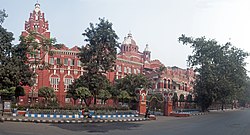Re-organisation
On August 1, 1955, the erstwhile Bengal Nagpur Railway portion was separated and a new zone, the South Eastern Railway, came into existence. [3] In July 1967, the South Eastern Railway took over the Bankura Damodar River line. Till April 2003, the South Eastern Railway comprised eight divisions: Kharagpur, Adra, Sambalpur, Khurda Road, Visakhapatnam, Chakradharpur, Bilaspur and Nagpur. In April 2003 two new zones were carved out from the SER. On April 1, 2003, the East Coast Railway (ECoR) comprising South Eastern Railway's Khurda Road, Sambalpur and Visakhapatnam divisions was dedicated to the nation; on April 5, 2003, the South East Central Railway (SECR) comprising South Eastern Railway's Nagpur and Bilaspur divisions and a new Raipur division was dedicated to the nation. On April 13, 2003, the SER reorganized Adra and Chakradharpur divisions to form the new Ranchi division. [4] The South Eastern Railway has electric multiple unit sheds in Tikiapara (near Howrah), Kharagpur and Panskura. Electric locomotive sheds are in Santragachi (near Howrah), Tatanagar, Bokaro Steel City, Kharagpur and Bondamunda (near Rourkela). Diesel locomotive sheds are located in Kharagpur, Bokaro Steel City, and Bondamunda. The coach maintenance yards of this zone are located in Santragachi (near Howrah), Hatia (near Ranchi) and Tatanagar. The South Eastern Railway has a major workshop located in Kharagpur, [5] and one Engineering Workshop is located in Sini under the Chakradharpur division, and also a Diesel loco shed in Bondamunda (near Rourkela).















